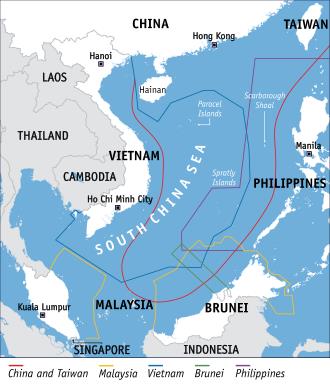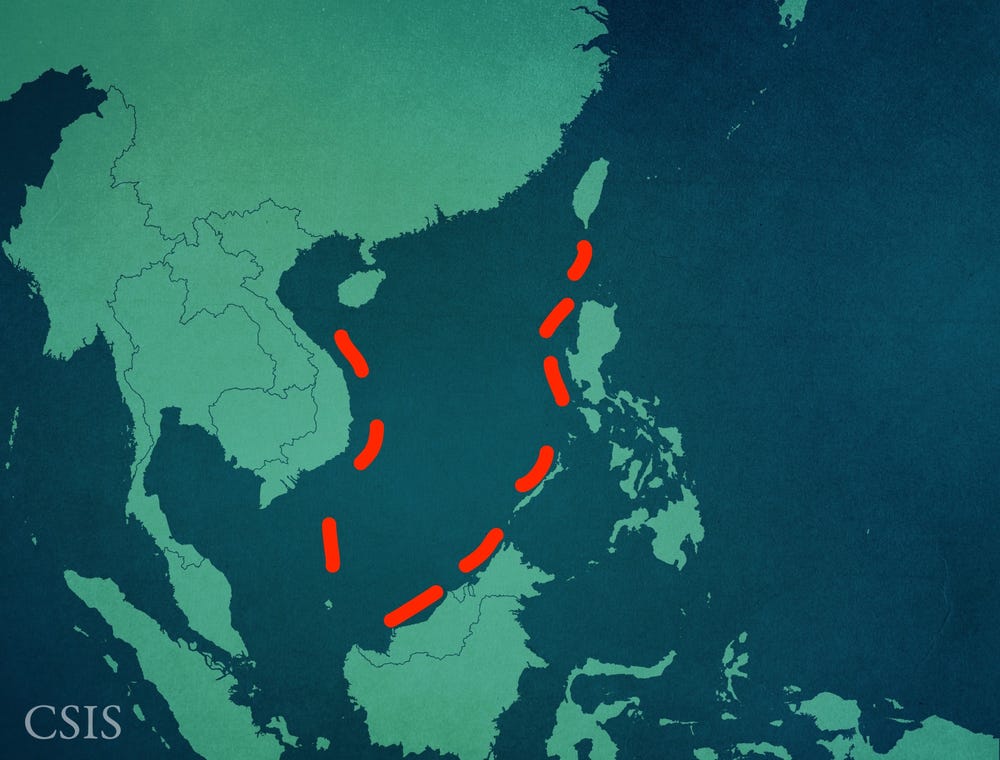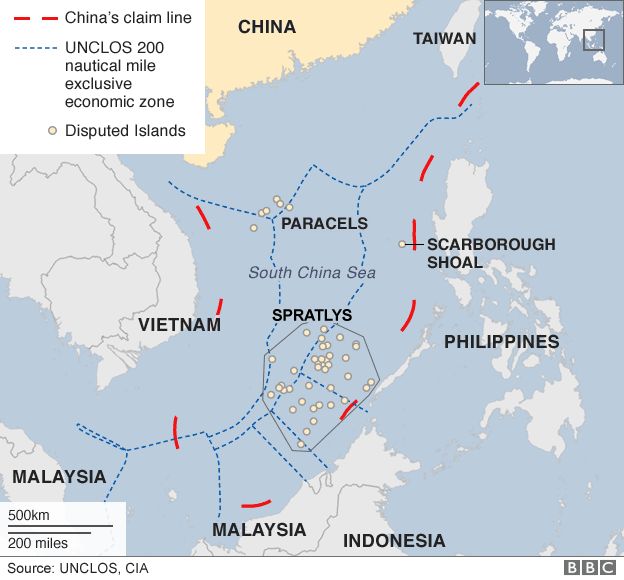
China’s Stance & Actions In The South China Sea
✍️ Achal Lokesh Ambiger
Published: 2022-12-29
China’s Stance & Actions In The South China Sea
By Achal Lokesh Ambiger
Introduction
The South China sea is a sea of immense importance in every facet of the necessities that a Nation would require, ranging from the most important and crucial trading routes, ports, and straits that very well hold the world together to one of the most important military waters in the world. It feeds millions due to its fisheries, While the Straits of Malacca, Lombok, and Sunda are vital for the World Economy as a 3rd of all maritime shipping occurs through it, an annual of 3 Trillion USD per year. As though this wasn’t enough, it also contains an immense reserve of Oil and Natural gas, 28 billion barrels of Oil and 266 trillion cubic feet of Natural Gas, to be precise.
It’s a sea that is shared by many Nations, While some require it more than others due to the immense dependence which has been developed upon it. This makes it a prime target for dispute.
To fully understand China’s stance and actions, We must first understand the historical aspects of both China’s ruthless ambition and the Sea itself.
History
The South China Sea was originally called so, in the Yizhoushu, chronicle of the Western Zhou dynasty, as the Nanfang Hai, “The Southern Sea”. The Sea held immense importance, it was considered one of the 4 Seas that make up Chinese Literature.
But the English name itself comes from the European trading expeditions to China, during which the Portuguese named the sea, Mare Da China, “The China Sea”, later being dubbed The South China Sea as We know today.
Later in WW2, the Japanese had nearly unparalleled control over the sea which ratified the name.
Since its very inception, it has held incredible importance in trading routes and has fed millions of Humans for many millennia.
We must ponder on the question of where all of China’s New found Ambition arise from.
Ever since the Chinese Communist Party came to power on October 1st, 1949, it has been in a constant state of struggle and Chaos, caught up in its grandiose delusions of the supremacy of the Marxist Ideology, trying to do whatever it takes to maintain the iron grip of an Autocratic Government, over 1.4 billion Citizens.
The afterthought of the Soviet collapse drives their leaders to go to enormous lengths to keep the system in check, like plunging the country into madness during the Cultural Revolution and killing hundreds or perhaps thousands of its citizens amid the Tiananmen Square protests in 1989, just to name a few.
But one of the most important side effects of this desire is the need to regain the territories lost during the turbulent 20th Century. This leads to an aggressive, non-stop expansionist agenda, which draws ire in the eyes of all the nations that border China.
“We cannot lose even one inch of the territory left behind by our ancestors”
This was Stated by the President of China, Xi Jinping.
Beijing also claims some 90 percent of the South China Sea, one of the world’s most commercially vital waterways, as its sovereign possession, which is the very topic of this article.
China relies on the South China Sea immensely, this leaves it in a very vulnerable state if anything were to occur to its trade & supply of energy that comes from it. The Straits of Malacca, Lombok, and Sunda are very crucial to China’s trade, any blockade upon it would completely leave China devastated.
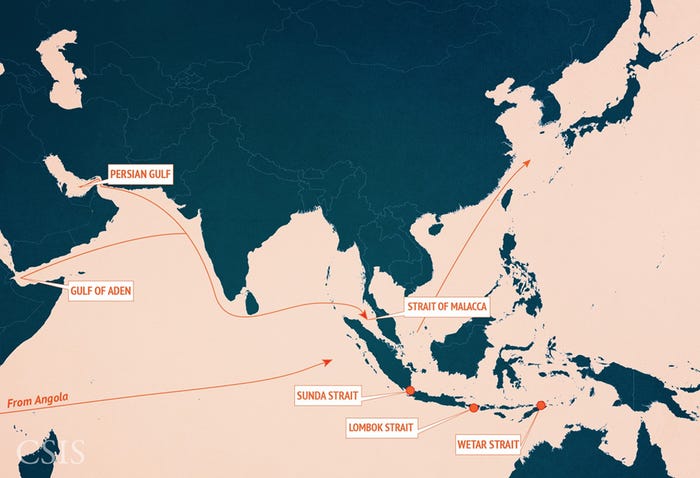
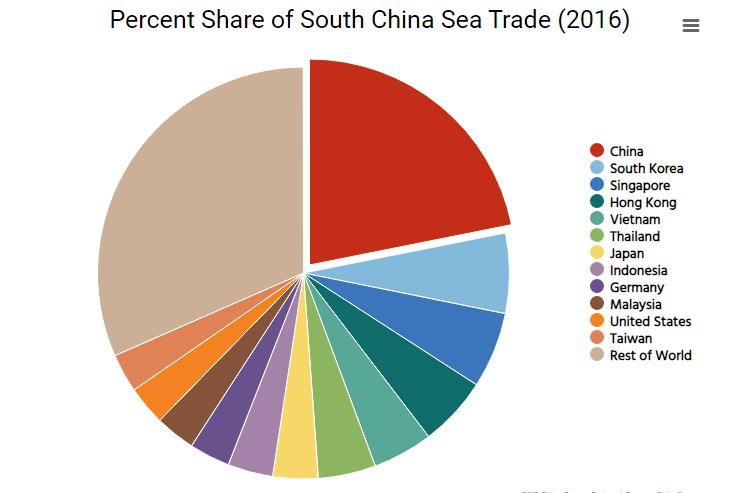
Not only in terms of economy, but militarily, the South China Sea is of unparalleled strategic importance to a country like China if wants to be able to defend itself against a Superpower like the United States. Chinese historians who reflect on what China calls “the century of humiliation” know that the Western powers - British, French, and American, entered China in ships across the South China Sea. It makes sense that China today, with that memory in mind, would want to protect its underbelly from maritime assault.
The numerous islands and military bases, give any country that has total dominion over it, such power that it truly cannot be controlled.
Now that the basis of why China has been aggressive in its quest for control over the Sea has been established, now We must look at the actions that it has taken to complete its ambition.
China’s Stance, Actions & Agenda
The South China Sea is no stranger to disputes, the complexity of the various claims and interests in the area has led to World tensions. But within the dispute, 6 Nations stand out, not only China but Brunei, Malaysia, the Philippines, Taiwan, and Vietnam as well.
Regardless, no other nation has come remotely close to matching the speed and scale of China’s efforts. In just two years, unannounced and unilateral acts of dredging and reclamation have created more than 3,200 acres of usable hard surface on the seven features that China occupies in the Spratlys. Ports, runways, buildings, and barracks have been built to accommodate military or civilian ships, planes, and personnel. Radar systems have been installed. Floating nuclear-energy platforms are envisioned.
In terms of Chinese law, South China Sea is part of the Hainan province, effectively already under the CCP’s administration and possession; A conviction embodied in the ban on foreigners who fish in them without China’s prior permission.
In July 2016, an arbitration tribunal constituted under Annex VII of the United Nations Convention on the Law of the Sea (UNCLOS) ruled against the PRC’s maritime claims, but neither the CCP nor the Government of Taiwan recognized the tribunal.
Surface-to-air missiles have been placed on Woody Island in the Chinese-controlled Paracels. China may build Scarborough Reef into a third platform, completing a strategic triangle with the Spratlys and the Paracels. The resulting network of bases could undergird the declaration of an air defense identification zone designed to subject foreign aircraft to Chinese rules.
Beijing has taken an active role in subsidizing archeological digs to find evidence of exclusive Chinese usage of the Sea’s many features since time immemorial.
In May 2009, Malaysia and Vietnam sent a joint submission to the Commission on the Limits of the Continental Shelf setting out some of their claims. China responded to the joint submission by submitting a map containing the infamous “nine-dash” line. This line snakes around the edges of the South China Sea and encompasses all of the sea’s territorial features as well as the vast majority of its waters. However, China has never officially clarified what the line is meant to signify. Instead, it has maintained “strategic ambiguity” and said only that “China has indisputable sovereignty over the islands in the South China Sea and the adjacent waters, and enjoys sovereign rights and jurisdiction over the relevant waters as well as the seabed and subsoil thereof.”
The final layer of China’s strategy focuses on achieving global power and, eventually, global primacy. Xi Jinping has talked of creating a global “community of common destiny” that would involve “all under heaven being one family”.
In Spring 2010, CCP officials communicated to US officials that the South China Sea was “an area of ‘core interest’ that is as non-negotiable” and on par with Taiwan and Tibet on the national agenda. However, China appeared to have backed away from that assertion in 2011.
In order to satisfy it’s agenda, China has been “Salami Slicing”, a strategy by which the government of China uses small provocations, none of which would constitute a casus belli by itself, but cumulatively produce a much larger action or result in China’s favor which would have been difficult or unlawful to perform all at once.
China also uses the strategy of “Cabbage Wrapping”, by which the Chinese Navy overwhelm a island by completely surrounding it with it’s Navy.
But the Main Disputes in the Sea are the following,
- The Nine Dash line claimed by China
- Maritime boundary along the Vietnamese coast between the PRC, Taiwan, and Vietnam.
- Maritime boundary north of Borneo between the PRC, Malaysia, Brunei, Philippines, and Taiwan.
- Islands, reefs, banks and shoals in the South China Sea claimed by China, Taiwan, and Vietnam, and parts of the area also contested by Malaysia and the Philippines.
- Maritime boundary in the waters north of the Natuna Islands between the PRC, Indonesia, Taiwan and Vietnam.
- Maritime boundary off the coast of Palawan and Luzon between the PRC, the Philippines, and Taiwan.
- Maritime boundary, land territory, and the islands of Sabah, including Ambalat, between Indonesia, Malaysia, and the Philippines.
- Maritime boundary and islands in the Luzon Strait between the PRC, the Philippines, and Taiwan.
These very points make the Sea a boiling cauldron of instability, which has yet to be resolved.
Artificial Islands
Perhaps the most crucial action that we must look at is Beijing’s island-building frenzy in the South China Sea.
Ever since the Japanese Empire collapsed after WW2, the Sea, which was under complete Japanese rule during the duration of the war was immediately claimed by China. Beijing put forth its infamous “Nine Dash Line” which is an extremely ambiguous chain of lines that covers 90% of the sea and effectively puts it under complete Chinese Administration.
But according to the Exclusive Economic Zone (EEZ), as prescribed by the 1982 United Nations convention on the law of the sea, every Nation has a “Sovereign Right” to the waters that are (12 nautical miles from the baseline) out to 200 nautical miles (nmi) from the coast of the state in question. It is also referred to as a maritime continental margin.
While the remaining waters are meant for international trade and nothing else.
But once again, there is a vast difference between full Sovereignty and Sovereign right, the EEZ only allows Nations to have special rights regarding the exploration and use of marine resources, including energy production from water and wind from that part of the sea that comes under their jurisdiction.
Now in the South China Sea, numerous countries have claimed 200 Nautical Miles of the sea, but Beijing refuses to acknowledge them, stating time and time again that nearly all of the Sea, comes under China as a part of the Nine Dash Line, which very goes completely against the UN law.
So to enforce these claims, Beijing has been converting reefs in an area called the Spratly islands into hard ground for the construction of military bases, runways, advanced radar systems etc.
Beijing has rapidly been constructing these islands in an unbelievably fast pace, some estimates say even 3 acres of land being made per day.
These islands once fully constructed are quickly converted to a military island which easily allows Beijing to dominate the region even though the Spratly islands are very well beyond the 200 nautical miles from their shores.
Once fully complete, Beijing will be able to claim the air space of the the Spratly islands which restrict any sort of air movement in the region without the consent of the CCP.
The United States & the Sea
We truly cannot talk about an international dispute without bringing in the juggernaut that has been dominating world politics for a century now.
Regardless of being extremely far from the sea itself, the US has many interests in the region, some may be beneficial to itself, some may be a counter against Beijing, but regardless, the US has key allies in the region such as the Philippines, whose sovereign rights to the waters are being completely infringed.
In order to safe guard their interests and the interests of their allies, the U.S. has recently begun freedom of navigation (FONOPS) maneuvers to defend its power projection capabilities into the theater and has requested assistance from regional partners to this end.
The FON, Freedom of Navigation, is a law which states that ships flying the flag of any Sovereign Nation shall not suffer interference from other states, apart from the exceptions provided for in international law.
“freedom of movement for vessels, freedom to enter ports and to make use of plant and docks, to load and unload goods and to transport goods and passengers”.
But in order the fulfil these manoeuvres, the US requires it’s allies – The Japanese, Australian and Indian to fully participate, but all of which have been reluctant to directly partake.
The US has been very consistent in their stance of championing a free and open Indo-Pacific.
The US has also stated that Beijing’s claims to offshore resources across most of the South China Sea are completely unlawful, as is its campaign of bullying to control them.
In a press statement, Michael R. Pompeo, Former United States Secretary of State, stated on July 13th, 2022
“The PRC has no legal grounds to unilaterally impose its will on the region. Beijing has offered no coherent legal basis for its “Nine-Dashed Line” claim in the South China Sea since formally announcing it in 2009.
The PRC cannot lawfully assert a maritime claim – including any Exclusive Economic Zone (EEZ) claims derived from Scarborough Reef and the Spratly Islands – vis-a-vis the Philippines in areas that the Tribunal found to be in the Philippines’ EEZ or on its continental shelf. Beijing’s harassment of Philippine fisheries and offshore energy development within those areas is unlawful, as are any unilateral PRC actions to exploit those resources.
As Beijing has failed to put forth a lawful, coherent maritime claim in the South China Sea, the United States rejects any PRC claim to waters beyond a 12-nautical mile territorial sea derived from islands it claims in the Spratly Islands
The PRC has no lawful territorial or maritime claim to (or derived from) James Shoal, an entirely submerged feature only 50 nautical miles from Malaysia and some 1,000 nautical miles from China’s coast. James Shoal is often cited in PRC propaganda as the “southernmost territory of China.”
The world will not allow Beijing to treat the South China Sea as its maritime empire. America stands with our Southeast Asian allies and partners in protecting their sovereign rights to offshore resources, consistent with their rights and obligations under international law. We stand with the international community in defense of freedom of the seas and respect for sovereignty and reject any push to impose “might makes right” in the South China Sea or the wider region.”
These statements would be sufficient to understand the stance of the United States on the matter of China’s actions in the South China Sea.
My Thoughts/Opinions
My Stance
Ever since China has been under the control of the CCP, it’s ambition has become limitless, in a way to regain the “Lost Respect” after being humiliated by the Western powers. This drives Beijing to incredible extents to accomplish it’s agenda. Being an autocratic government is also difficult when you have a population of 1.4 billion; So the propaganda, the manipulation, the deceptions are the very essence of what they’re built on, alike to the Soviets.
The UN has made very clear what the EEZ is and stands for, to outright disobey the UN and infringe the rights of several independent Nations and yet have no remorse simply shows the intent of the PRC.
The sea is incredibly vital for the World Economy, as 30% of all the world’s maritime trade occurs through it, controlling such a region would give a edge enough to be a world juggernaut by far. The plentiful resources are too many for a singular country to have, if we wish to maintain the World peace that we currently have.
Any nation with complete access to all the resources, fisheries, strategic bases and a hold on the World trade of the Sea itself is unstoppable.
To simply use a ambiguous “nine dash line” to claim the Sea, is utterly disgraceful and to continue to ratify these claims, as they did in 2009, is horrible to witness.
Not only this, but to build artificial islands in a region far from the shores of Mainland China, by converting reefs is surely a casus belli itself. Surely after the completion and occupation, the air space itself will be under the PRC’s administration giving it unparalleled dominance in the region.
The Sea itself is essential to China’s economy, without which, the vital supply of energy that China is so dependent upon is left to the mercy of the world, something that the CCP simply cannot fathom.
China’s actions are absolutely unacceptable in every way possible, there is truly no other viewpoint from which to look upon and cut them any slack.
These actions are hindering the already delicate and extremely fragile peace of the World, they are infringing the rights of many nations and has many nations worried about the security of their people & country.
In conclusion, I am convinced that Beijing’s intent and actions are completely nationalistic & devious in nature and should not be looked upon and ignored but rather solved diplomatically, for there is no other alternative.
Thank you

